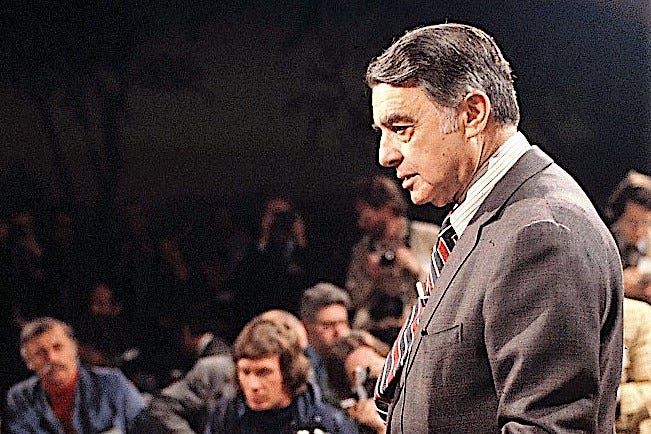The Man Who Transformed Instant Photography Forever
Written on
Chapter 1: The Spark of Inspiration
Edwin Land's journey into instant photography began when his three-year-old daughter asked why she couldn't see a photo of herself right away. This question ignited a groundbreaking idea.

Edwin H. Land, 1937. Gotfryd Bernard, photographer, Public domain, via Wikimedia Commons
In today's world, digital photography offers instant gratification, allowing us to view photos almost immediately on various devices. Before this era, traditional photography involved developing negatives and printing images—a process that was time-consuming. The advent of instant photography bridged the gap to digital photography, marking a significant achievement in the field. Edwin Land, who held an impressive 533 U.S. patents, was pivotal in this revolution, second only to Thomas Edison.
The Fascination with Light
Before the creation of instant photography, Land was intrigued by the concept of light polarization. Polarization allows certain light waves to pass while blocking others, effectively reducing glare. Although natural polarizers existed, they were often bulky and expensive. Even as a teenager, Land envisioned the possibility of creating synthetic polarizers to mitigate the glare from car headlights at night.
Although he enrolled in Harvard University to study physics, Land soon left to pursue his experiments on polarization. By 1929, he filed a patent application and, by the following year, had developed a method for the commercial production of polarizing sheets. Together with George Wheelwright, he established Land-Wheelwright Laboratories in Cambridge, Massachusetts, which manufactured affordable polarizers used in various products, including photographic filters and polarized sunglasses.
The company later adopted the name "Polaroid" when it became public in 1937, just before the U.S. entered World War II. During the war, Polaroid Corporation provided crucial supplies to the military, including anti-glare goggles for soldiers and pilots, and a "vectograph" that allowed for three-dimensional visualization of battlefields. Land also served as a consultant for the National Research Defense Committee and contributed to Cold War technologies.
A Breakthrough Idea
In 1943, while on vacation and photographing his daughter Jennifer, Land's inspiration struck when she inquired why she couldn't see the image immediately. This moment led him to ponder the mechanics of instant photography. He quickly contacted a patent lawyer and began working on his concept. Reflecting on this experience years later, Land remarked, "Within an hour, the camera, the film, and the physical chemistry became so clear."
At that time, conventional photography necessitated laboratory processes involving chemical baths to develop film. Land aimed to streamline this by creating a process that would occur within the film itself, necessitating the design of a specialized camera and film.
His innovative approach combined negative film, positive paper for the image, and a reservoir of chemicals that initiated and halted film development. The camera would force the print through rollers, allowing for instant processing. Keeping the details of this development secret, Land waited until 1946 to unveil his invention.
The Launch of Instant Photography

The introduction of instant photography occurred in early 1947 when Polaroid Corporation was ready to launch its innovative technology. On February 21, 1947, Land personally demonstrated the new camera and film at a meeting of the Optical Society of America, receiving acclaim for this achievement. The "Model 95 Polaroid Land Camera" debuted in a Boston department store in 1948, and it sold out almost immediately. However, the initial prints were sepia-toned, requiring a wait of sixty seconds before the image could be revealed. By 1950, the company had improved its technology to produce black-and-white prints.
Over the next two decades, Polaroid Corporation capitalized on its unique instant photography process. The development of color photography was more complex, necessitating numerous technological advancements before Polaroid's instant color film was finally launched in 1963. This new product was a massive success, with film sales skyrocketing by 600% in the following decade.
A significant milestone in instant photography came with the launch of the "Polaroid SX-70 Land Camera" system. Although the process appeared simple—where users merely pressed a button to receive a photo—it involved sophisticated technology that allowed a quality full-color image to develop automatically, eliminating the need for peeling apart film.

The Marketing Genius
While instant photography was a compelling product in itself, Polaroid Corporation aggressively marketed its cameras and films through various media. In the 1960s, the company launched an innovative campaign, enlisting renowned photographers and artists like Ansel Adams and Andy Warhol to explore their creativity with Polaroid film. This initiative resulted in the "Polaroid Artists Collection," which grew to include 16,000 prints by 120 artists.
When Kodak attempted to release its own version of instant photography in 1976, Polaroid promptly took legal action and, after a ten-year battle, won the case, preventing Kodak from producing instant cameras.
Regarded as the Apple of its time, Polaroid's fortune was not everlasting. Following the failed introduction of a color motion picture system called Polavision, Edwin Land departed from the company in 1981. The decline of instant camera sales in the 1980s, coupled with the rise of one-hour color processing technologies in the 1990s, contributed to Polaroid's struggles. Land passed away in 1991.
Despite attempts to revive the brand with new products, Polaroid declared bankruptcy in 2001, attempted to rebrand as a digital company, and faced a second bankruptcy in 2008. However, in 2017, the Polaroid name and its intellectual property were acquired, and the company has since made a comeback, once again promoting the idea of instant photography first envisioned by Edwin Land.
This video explores how Polaroid transformed the landscape of instant photography.
In this video, discover how modern innovations continue to impact film photography.
Sources
- American Chemical Society, “Edwin Land and Polaroid Photography”
- Boston.com, “History of Polaroid and Edwin Land,” Oct. 3, 2012
- Coldewey, David. “We’ve come full rectangle: Polaroid is reborn out of The Impossible Project,” Mar. 27, 2020, TechCrunch